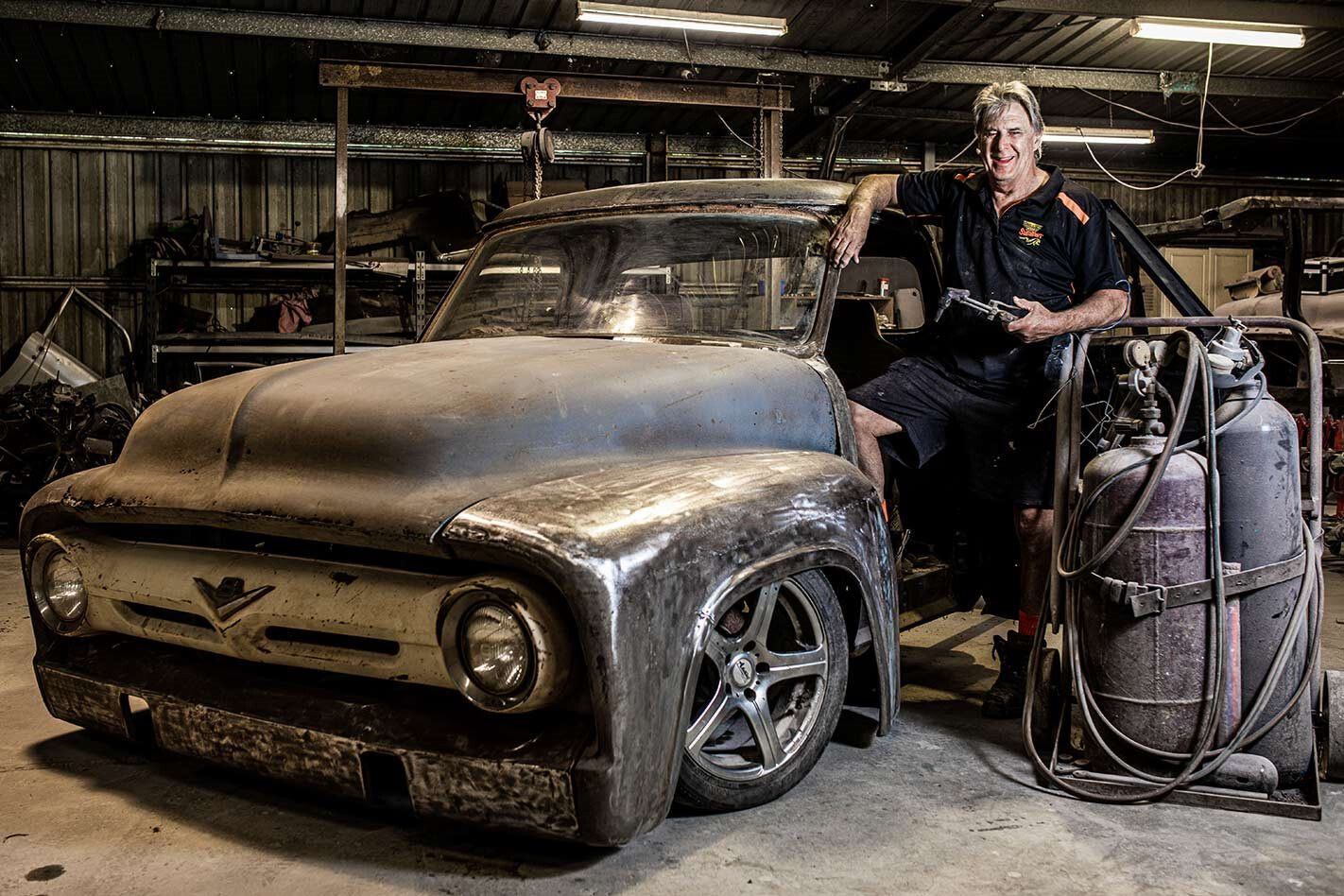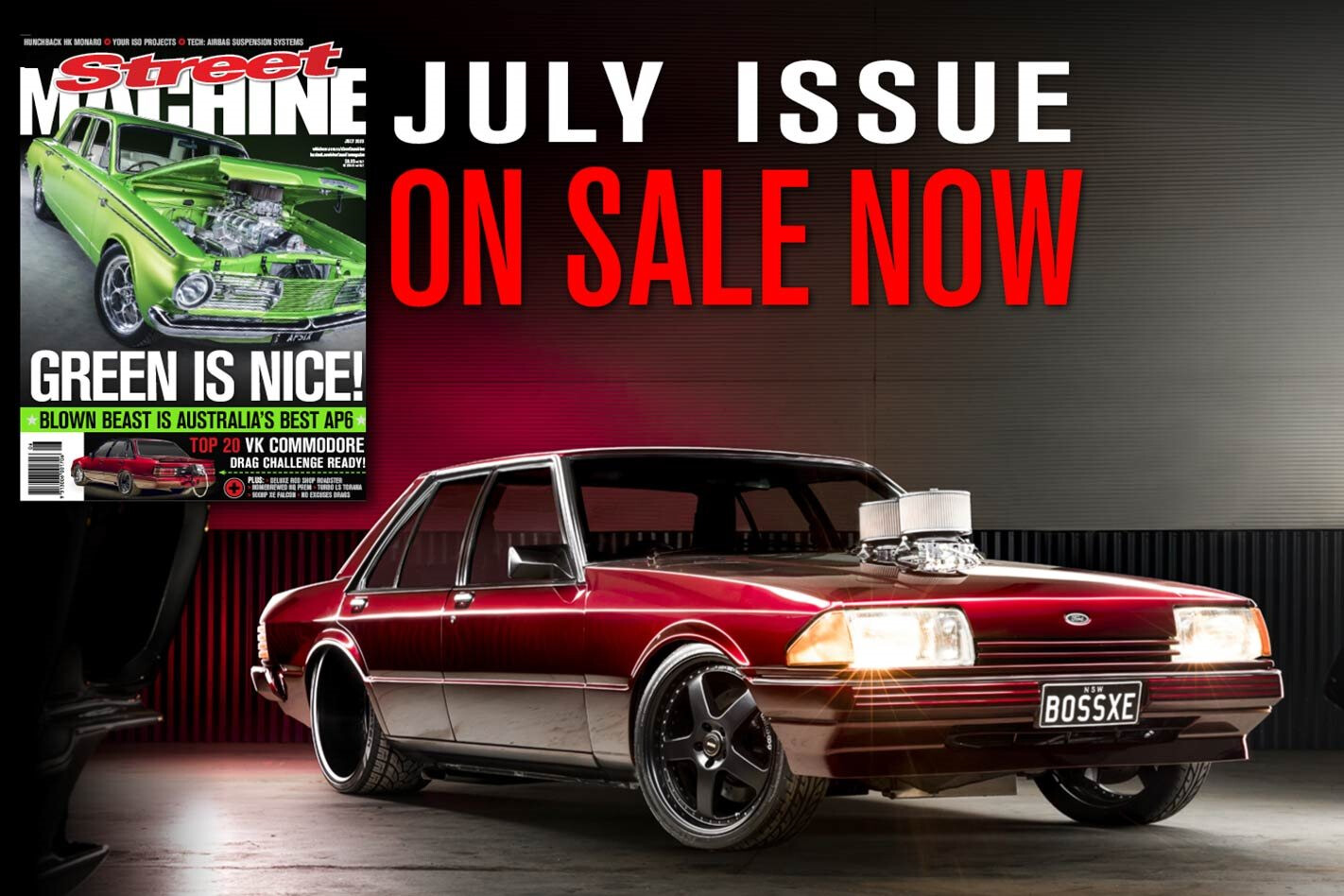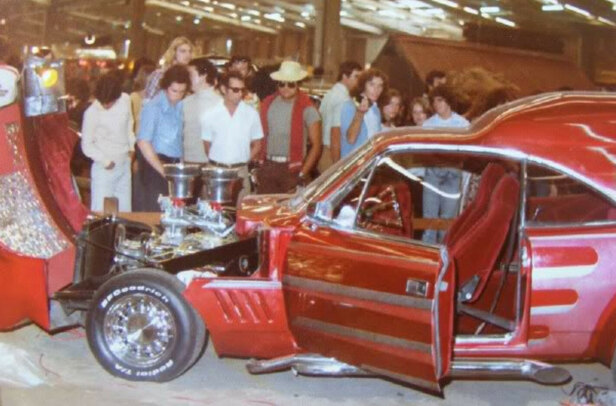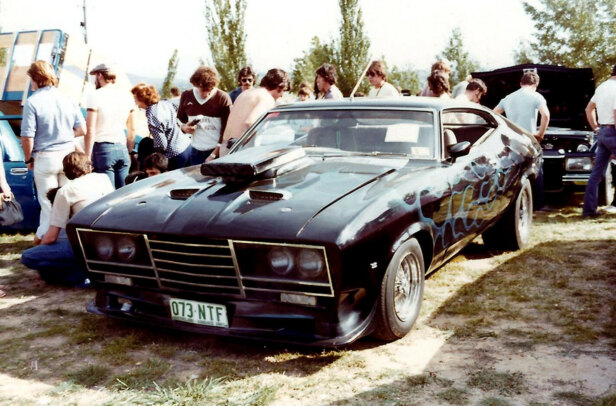THE Australian custom mindset of the late 1950s and 60s carried over into the styling of the panel vans and street machines built in the 1970s and early 80s. Hot-car people of those eras weren’t afraid to let their imaginations run wild, chopping and changing cars that were often less than a decade old and still plentiful as daily drivers. There was no concept of ‘wrecking a classic’ back then. Stephen Wilson was front and centre for all of this action and has numerous builds to his credit, but his wild custom Monaro panel van dubbed Hunchback is the stuff of legend.
This article was first published in the July 2020 issue of Street Machine
What sparked your interest in cars?
I used to go to hot rod shows with my older brother, Rowan, at Roselands in Sydney in the 60s and 70s. I’d come home from those shows and my mind would be bubbling over with creativity and wild ideas. In my late teens I started doing airbrushed mural work as a side gig while doing my painting and panel beating apprenticeship. I’ve always admired Frank Lee (SM, Jun ’15) and the mural work he created, and would rate him as Australia’s best.
What sort of cars inspired you as a young bloke?
I always loved wild cars like the Munster Koach from the old TV show The Munsters, and in that same vein was the GTO-based Monkeemobile from The Monkees. George Barris’s stuff was awesome, and at 15 I built a model of Bill Cushenbery’s space-aged car called Silhouette. My pushbike was black with flames and a T-bar shift just to make it stand out from the crowd, which was a sign of things to come – I wanted to create one-off cars that were definitely not like something that everyone else was driving. My first boss, Colin Mainprize, built hot rods. I bought a ’35 Ford five-window coupe from him with big plans to build a 70s show rod, but it was stolen before I got the chance to do it up.
What cars did you have in your earlier years?
I customised my first car, a MkII Zephyr, during 1971 and 1972. It featured rolled front and rear pans, live sidepipes, a re-peaked bonnet, custom grille and shaved door handles. I finished it with a custom lace paintjob using insert panels, and Colin Mainprize made the mag wheels for me – he used to market them as Action Mags, and the wheels for mine were the only 13-inch set he ever made. I had a TC Cortina 250 sedan with custom paint, and a Prefect van. I then built an HT ute called Bewitched, which ran a tunnel-rammed 308 along with custom body and paint, including a tube grille and rollpans, XC Fairmont headlights and XW Falcon tail-lights, sail panels for the sides, a rear wing and functioning truck stacks that exited through the tray – man, it was loud! I then created Devil’s Delivery from that ute by simply sheeting in the sides and top from the roof back to the wing, and adding a TC Cortina wagon tailgate. My builds were always evolving, as by this stage I ran my own business, Auto Art Custom Paint & Body Shop of Katoomba, which specialised in custom work.
Five of the best old-school custom cars
What got you into the judging scene at the early Street Machine Nationals and the like?
I met a guy called Cameron Lees who had a Persian Sand-coloured Holden van, which had the worst flame job you’d ever seen – the licks looked like fingers with bad arthritis. I offered to re-flame it for him and we fitted a full-length Statesman grille and the eight-trumpet fake injection air cleaner from Bruce Lynch’s old purple HQ van called The End. We took Cameron’s van – now dubbed Satan’s Palace – out to a park to take some photos, and by pure coincidence the Pegasus Van Club were there. They were blown away by Cameron’s van and asked me to judge their Dream Van ’77 show in Auburn later that year. The stuff I was building in the early 70s was pretty radical compared to what else was around at the time, and I think they liked that vision. This led to judging at hot rod and custom shows both in NSW and Victoria, and I was later the NSW chairman for the Street Machine Association. I remember attending a Gosford show in the late 70s purely as a spectator, and John Strachan of Alley Cat panel van fame spotted me and said: “Are you judging?” I told him I was just there to enjoy the show and he replied: “Thank god for that; I haven’t cleaned under the back of it properly.” I guess I had a reputation for being tough, but I would also have people asking for advice and guidance on how to improve their cars, and was always happy to spend time with them.
I clearly remember your custom Hunchback panel van build from the late 1970s and early 80s – it would have to rate as one of Australia’s wildest customs. How did the idea come about?
I was in my early 20s and involved in the Demons Car Club. One night while waiting for a club meeting to start, I was thumbing through a mate’s magazine that showed an artist’s impression of a futuristic Falcon panel van that used side windows from a Falcon hardtop, as well as a photo of a ’33 Dodge panel delivery with a stepped turret. Those ideas basically morphed and the Hunchback concept just blossomed from there. I already had a tidy HT van as my everyday car and picked up a damaged HK Monaro shell from the local tip – they were worth nothing back then – and started building. I’ll never forget what happened after I cut the HT van in two; my ex-mother-in-law just spat the dummy and screamed: “Are you insane?” I’d bought the HT from a car yard and it was still under finance – she just couldn’t believe her eyes [laughs].”
I remember the first black guise of Hunchback, then the candy apple red incarnation with murals, and lastly the silver-with-graphics look. What instigated these transformations?
The black version was just a quick blow-over to get it on the road for the 1980 Street Machine Nationals; six weeks before the Nats it was literally a bare shell, so I just ran out of time to do anything better with the paint. I had intended to take my Devil’s Delivery Holden, so I brought it into my workshop to start filling 87 floor holes as part of an undercarriage revamp. I had a bunch of mates working on their own cars there at the time, who out of frustration carried in the Hunchback body shell and said: “Just finish this!” And that was that! The delivery supplied the running gear and many of the other parts to get Hunchback on the road, and once the Nats were done I took it all apart and finished it properly with bigger flares, more body mods and a tunnel-rammed small-block Chev. That’s when I painted it candy red with murals. It was a daily driver that saw plenty of highway use too, so after a few years and plenty of stone chips I redid it fresh in silver, as everyone knows what a pain candy is to match.
When did you sell Hunchback?
I think it was around 1985, and yes, it was a bloody hard decision. I’d pretty much achieved everything I ever wanted with that car, and there are always other dream projects floating around in your mind that you want to make a reality. I ended up parting it out to get as much money as possible, and the 350 and tunnel-ram set-up is apparently the one in the late Pat Fay’s FJ hearse. I sold the body with all the trim intact to a guy in Brighton-Le-Sands – he had a car alarm business and was going to use it as a work promo vehicle. Sadly, that is the last I ever heard of it. There’s always been a few rumours floating around that it was scrapped or is hidden away in a Sydney shed, but until I see proof of its fate you’re just never going to know 100 per cent. It’s such a unique car that someone must know if it survived or where it may be.
Do you have any projects on the go right now?
I have six projects in build at the moment, from factory restos to another wild custom, so yep, old habits die hard. They include an HZ One Tonner that I bought cheap to resell for profit but now sits completely stripped with its chassis about to get sandblasted – it just was so bloody handy in those early months with house renos and the like that I can’t part with it! I also have a 1953 Ford F100 pick-up that I’m building as a panel woody with factory-style rear guards, as well as another 1955 F100 that is a full wild custom with a roof chop and shifted wheelarches. The ’55 will have a custom pick-up bed along with a mid-engine transaxle set-up so is definitely going to be like nothing else. My wife Jenny has a 1961 Oldsmobile bubble-top. It is our comfortable cruiser, soon to score custom lowrider-style paint, a larger 403 Olds engine and Air Ride suspension. I’m also deep into the build of a twin-cab XY 4WD utility.
Do you think the freedom in the 70s and 80s to build cars to an identity without people accusing you of ‘wrecking a classic’ is what made cars like Hunchback so memorable?
Yes, definitely. The value of cars such as Falcons and early Holdens was nowhere near as high; we could pick them up for next to nothing. Working in the panel trade also meant we could access plenty of wrecks to play with. I’ve modified probably six or more Monaros and early Holdens, and probably the same for XW and XY Falcons as well as XA and XB hardtops – I only wish I had those cars now so I could retire with a fat bank account [laughs]. But in saying that, being able to build your dreams and exercise the creativity in your brain is more satisfying than sitting on any extra money ever could be. Life is a lot more fun when you use your imagination!
SPECIAL thanks to the Wilson family, especially Stephen and Jenny’s youngest daughter, Jodie-Anne Wilson-Hocking, for making this story possible. Thanks also to photographer Bryce Forrest for the present-day photos.
HUNCHBACK VAN:
Hunchback’s humble beginnings. “I bought this HT van from a Sydney car yard with plans to build another custom,” Stephen says.
“When it came up for rego, I took it off the road and started the custom work, but then the idea to build a Monaro van reared its head, so I sourced an HK Monaro shell, cut the turret and rear quarters off the van and matched it to the Monaro roof and boot profile.”
Hunchback taking shape, with the major turret work sorted and the front subframe modified for the tilt front. “It nearly killed me,” Stephen says. “I had the rear of it lifted up to the roof of the shed using rope and a block and tackle so I could walk under it. I stepped out just before the rope snapped and the car fell to the floor!”
Hunchback’s first guise was finished just in time for the 1980 Street Machine Nationals. Apart from the obvious roof conversion, the body mods also included a one-piece lift-up tailgate, XB GS bonnet graft, LTD tail-lights, frenched aerials, Morris Marina door handles and a tilting custom front.
After the 1980 Nats, Hunchback underwent a total rebuild. Bigger rear flares were made to house the fat chrome 12-slots and wider rear 9in conversion, while the front brakes were upgraded to XB discs and rotors. A tunnel-rammed 350 Chev replaced the 308 and the exterior copped a candy red respray with new graphics and murals.
The Hunchback’s final transformation saw Stephen respraying it in silver with graphics, perfectly on-trend to make a splash at the 1984 Street Machine Nationals. It was later parted out and sold, with the 350 Chev rumoured to have made a home in the late Pat Fay’s famous FJ hearse.
BETWITCHED UTE:
The Bewitched ute had morphed into Devil’s Delivery by the late 1970s, with Stephen building sides and a roof panel to join the turret to the rear wing, and adding a Cortina wagon tailgate. The custom front was then further modified and the whole car treated to fresh paint. It was later used as a parts donor for Hunchback.
Stephen’s ‘Bewitched’ HT ute was a period-perfect Aussie custom street machine. “Bewitched was my work ute, show car and promo vehicle that ran a tunnel-rammed 308 Holden and a heap of body mods, including Falcon lights and custom paint,” Stephen says.
“That’s me with my wife Jenny, eldest daughter Samantha looking cool in sunnies at the front and our second daughter Rachael in my arms,” Stephen says of this family snap in front of the Bewitched ute. “Our youngest daughter Jodie-Anne wasn’t far off – she was conceived at the 1980 Street Machine Nationals! I’ve been lucky to have a very supportive family who share the passion for cars. My daughters and grandchildren are already fighting over my collection!”
STEPHEN’S OTHER BUILDS & MODS:
Stephen’s first car was this MkII Ford Zephyr that he customised with period body mods, custom lace paintwork and a spray-on imitation vinyl roof (remember those?). He hotted up the Zephyr six-cylinder and rolled around on 13in Action Mags wheels. “It took a year to build, but was only on the road for four months; heading home in drizzly rain, I stopped for a red light and an old guy in a Rambler wagon punched it up the back and wrote it off.”
Stephen’s wife Jenny owns this 1961 Oldsmobile bubble-top. Rare even in the US, it is one of only three to be found on Aussie shores. “Jenny is the most amazing woman you will ever meet,” Stephen says. “When things were going crazy at the workshop, she would work a full day at her own job, then cook and deliver us dinner, before coming back at midnight with a nightcap.”
Stephen’s first hot rod build was to be this 1935 Ford five-window coupe he bought from his old boss, the late Colin Mainprize. “It wasn’t even 40 years old back then and the body was actually in reasonable shape – the front guards and mint grille were inside the car, and it had the wind-down rear screen and dickie seat,” Stephen says. “Unfortunately it got stolen before I could even make a start.”
This HD van was Stephen’s first work vehicle when he opened his Auto Art Custom Paint & Body Shop business in Katoomba, NSW. “I painted this van as a rolling advertisement,” he says. “It had everything from cobwebbing, bubbles and sun spots to flames and lacework.”
This VC Valiant ute was owned by Stephen’s business partner, Cameron Lees. “Many of the top-end panel vans and street machines of the day would be driven to shows and cleaned from front to rear when they arrived,” Stephen says. “Driving them was half the fun; no trailer queens back then!”
“I built this HR sedan for brothers Barry and Keith Bowdren for the second Street Machine Nationals,” Stephen says. “The panel sections were cobwebbed in brown with a maroon fogged edge and a gold pin-line.”
Stephen’s chopped and sectioned ’55 F100 build will feature a mid-mounted engine and transaxle assembly in its custom rear tray. The extent of the truck’s mods is evident alongside his mate Craig Langley’s beautiful Effie, which Stephen restored.
One of Stephen’s current projects is this super-cool twin-cab Falcon 4WD utility. It’s an XY ute that’s been stretched over a long-wheelbase Ford Maverick wagon chassis and features custom-made rear doors and turret. A shaker-clad 351 Clevo will power it, and the build will be styled along a GT-tribute theme.




Comments